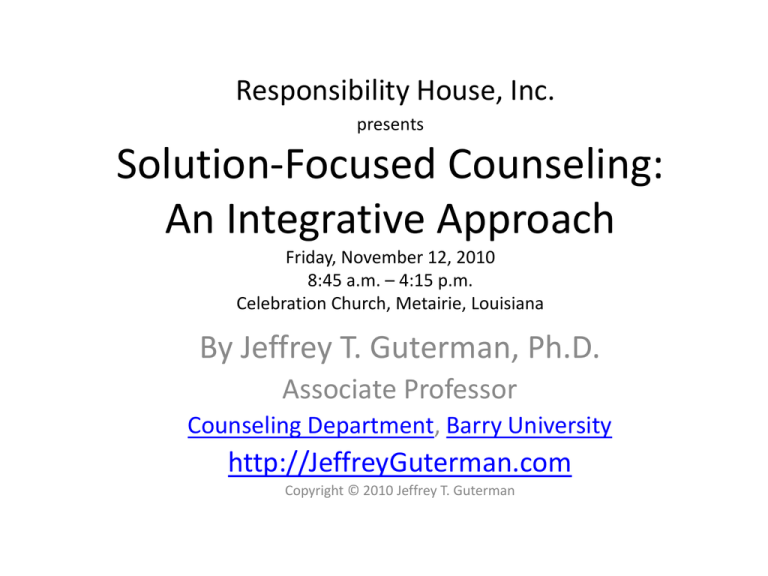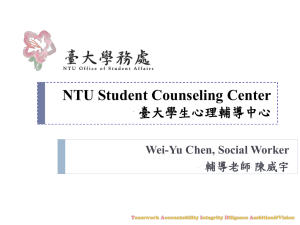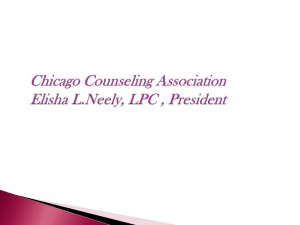Mastering the art of solution-focused counseling
advertisement

Responsibility House, Inc. presents Solution-Focused Counseling: An Integrative Approach Friday, November 12, 2010 8:45 a.m. – 4:15 p.m. Celebration Church, Metairie, Louisiana By Jeffrey T. Guterman, Ph.D. Associate Professor Counseling Department, Barry University http://JeffreyGuterman.com Copyright © 2010 Jeffrey T. Guterman Workshop Description Solution-focused counseling is a strength-based integrative model that emphasizes clients’ existing and potential problem-solving skills. This workshop offers an opportunity for clinicians of diverse orientations, roles, and settings to learn the theory and techniques of solution-focused counseling. Workshop participants are introduced to the clinical stages of the model. Case examples and research illustrate the solution-focused approach to a variety of clinical issues and populations, including clients with co-occurring disorders. The workshop includes exercises to help attendees quickly learn and apply the material. 2 Learning Objectives 1. Understand key concepts and principles that inform solution-focused counseling. 2. Understand the theory of problem formation and change corresponding to solution-focused counseling. 3. Understand the clinical theory of solution-focused counseling’s strategic approach for integrative treatment. 4. Understand the clinical stages in solution-focused counseling, including (a) co-constructing a problem and goal, (b) identifying and amplifying exceptions, (c) co-constructing tasks, (d) identifying and amplifying exceptions derived from tasks, and (e) re-evaluating the problem and goal. 5. Develop knowledge and skills for practicing various solution-focused techniques, including (a) solution-focused questions, (b) mapping influences of the problem, and (c) scaling techniques. 6. Develop knowledge and skills for the application of solution-focused counseling to a variety of clinical issues and populations, including clients with co-occurring disorders. 3 Introduction to Solution-Focused Counseling • Overview and introduction to solutionfocused counseling • Key concepts and principles for solutionfocused counseling 4 Introduction to Solution-Focused counseling Overview and introduction to solution-focused counseling • Solution-focused therapy was developed by Steve de Shazer (1985, 1988) and his colleagues at the Brief Family Therapy Center (BFTC) in the mid-1980s. • Precursors to solution-focused therapy. • The “formula first session task” (Molnar & de Shazer, 1987). 5 Introduction to Solution-Focused Counseling Overview and introduction to solution-focused counseling • The Mental Research Institute’s (MRI) problem-focused therapy (Watzlawick, Weakland, & Fisch, 1974) was a precursor to solution-focused therapy. • Various “solution-focused” models have been developed since the mid-1980’s. • Solution-focused counseling (Guterman, 2006) is an integration of solution-focused theories and techniques (de Shazer, 1985, 1988, 1991), postmodernism (e.g., Lyotard, 1979), and a strategic approach to eclecticism (Held, 1992). 6 Introduction to Solution-Focused Counseling Key concepts and principles for solution-focused counseling • • • • • • • Collaborative approach Solution-focus Small changes can lead to big results Emphasis on process, not content Strategic approach Brief by design, but not always Responsiveness to diversity 7 Solution-Focused Counseling Theory • Theory of problem formation • Theory of change • Strategic approach for integrative treatment 8 Solution-Focused Counseling Theory Theory of problem formation Solution-focused theory holds that for every “problem” there is an exception. An exception refers to “times when the . . . problem does not happen even though the client has reason to expect it to happen” (de Shazer, 1991, p. 83). 9 Solution-Focused Counseling Theory Theory of problem formation Problems are seen to maintain themselves simply because they maintain themselves and because clients depict the problem as always happening. Therefore, times when the complaint is absent are dismissed as trivial by the client or even remain completely hidden from the client’s view. Nothing is actually hidden, but although these exceptions are open to view, they are not seen by the client as differences that make a difference. For the client, the problem is seen as primary (and the exceptions, if seen at all, are seen as secondary), while for therapists the exceptions are seen as primary; interventions are meant to help clients make a similar inversion, which will lead to the development of a solution. (de Shazer, 1991, p. 58) 10 Solution-Focused Counseling Theory Theory of problem formation Problem/Exception 11 Solution-Focused Counseling Theory Theory of problem formation • Process/Content distinction – Process refers to what counselors and clients do (i.e., interventions, methods, and techniques) to facilitate change. – Content refers to the object of change in any given clinical theory. • Formal content refers to the counselor’s assumptions about the predetermined cause of problems that is addressed across cases. • Informal content refers to the client's subjective, idiosyncratic assumptions about the cause of a problem (Guterman, 2006; Held, 1992). 12 Solution-Focused Counseling Theory Theory of problem formation Formal content: Problem/Exception Informal content: Ineffective coping skills for depression Informal content subsumed by Formal Content: Ineffective coping skills for Depression / Effective coping skills for depression 13 Solution-Focused Counseling Theory Theory of change Problem / Exception 14 Solution-Focused Theory Theory of change Problems are seen to maintain themselves simply because they maintain themselves and because clients depict the problem as always happening. Therefore, times when the complaint is absent are dismissed as trivial by the client or even remain completely hidden from the client’s view. Nothing is actually hidden, but although these exceptions are open to view, they are not seen by the client as differences that make a difference. For the client, the problem is seen as primary (and the exceptions, if seen at all, are seen as secondary), while for therapists the exceptions are seen as primary; interventions are meant to help clients make a similar inversion, which will lead to the development of a solution. (de Shazer, 1991, p. 58) 15 Solution-Focused Theory Theory of change • Amplifying exceptions – Do more of the same – Observe for exceptions – Ascribe meaning to exceptions 16 Solution-Focused Theory Theory of change Problem/Exception 17 Solution-Focused Theory Theory of change • When is the problem resolved in solutionfocused counseling? 18 Solution-Focused Theory Strategic approach for integrative treatment • Generic approach vs. strategic approach • Two scenarios of strategic approach – The client’s worldview (informal content) is in keeping with the formal content of some other clinical theory and it is subsumed within the formal content (as informal content) of solution-focused counseling. – You determine that the client’s worldview is in keeping with the formal content of some other clinical theory and it is subsumed within the formal content (as informal content) of solution-focused counseling. 19 Solution-Focused Theory Strategic approach for integrative treatment Formal content: Problem / Exception Formal contest-as-Informal Content: Codependency Formal content-as-Informal Content subsumed by Formal Content: Codependency / Not Codependency 20 Clinical Stages in Solution-Focused Counseling • • • • Co-constructing a problem and goal Identifying and amplifying exceptions Co-constructing tasks Identifying and amplifying exceptions derived from tasks • Re-evaluating the problem and goal 21 Clinical Stages in Solution-Focused Counseling • The first session – Co-constructing a problem and goal – Identifying and amplifying exceptions – Co-constructing tasks • After the first session – Identifying and amplifying exceptions derived from tasks – Re-evaluating the problem and goal 22 Clinical Stages in Solution-Focused Counseling Co-constructing a problem and goal • Conducting an intake • Joining with the client 23 Clinical Stages in Solution-Focused Counseling Co-constructing a problem and goal • Don’t create a problem • Co-create a solvable problem 24 Clinical Stages in Solution-Focused Counseling Co-constructing a problem and goal • Questions for co-constructing a problem – What is the problem that brings you here today?" – "What brings you here today?" – "What would you like to accomplish through counseling?" 25 Clinical Stages in Solution-Focused Counseling Co-constructing a goal – Positive • Develop goals in positive language (i.e., as an increase of something) rather than negative language (i.e., as a decrease of something). – Measurable and specific • Ask clients to provide a video description. • In some cases, however, it might be preferable to generalize the goal due to its rigid specificity. – Small and limited • In some cases, the goal might be too large in scope. – Relevant to the problem and client • It is also important for the goal to fit with the client’s problem and worldview. 26 Clinical Stages in Solution-Focused Counseling Identifying and amplifying exceptions • Identifying exceptions – Identifying small exceptions – Identifying potential exceptions • Amplifying exceptions 27 Clinical Stages in Solution-Focused Counseling Identifying and amplifying exceptions • Identify exceptions – Questions aimed at identifying exceptions • “When has there been a time?” (presuppositional questions) • Identify small exceptions – If the client says there are no exceptions, identify small exceptions. • Identify potential exceptions – If the client is unable to identify small exceptions, identify potential exceptions. 28 Clinical Stages in Solution-Focused Counseling Identifying and amplifying exceptions • Miracle question “Suppose that one night there is a miracle and while you are sleeping the problem that brought you into therapy is solved: How would you know? What would be different?” (de Shazer, 1988, p. 5) 29 Clinical Stages in Solution-Focused Counseling Identifying and amplifying exceptions • Case example to illustrate identifying an exception A client was self-referred for work problems. For the past five years, he had owned and operated a convenience store. The client reported that he has frequently felt anxiety and stress at work when he is understaffed and therefore is not able to get home in the afternoons. The client reported that the staffing problem is something that he cannot change at this time because he cannot afford to hire more staff. 30 Clinical Stages in Solution-Focused Counseling Identifying and amplifying exceptions • Case example to illustrate identifying an exception Problem Ineffective coping with anxiety and stress at work / Effective coping with anxiety and stress at work Goal Increase effective coping skills at work 31 Clinical Stages in Solution-Focused Counseling Identifying and amplifying exceptions • Case example to illustrate identifying an exception – Counselor: Would you tell me about a time when you found that you have been able to deal better with stress at work? – Client: I would say when I am fully staffed and I am able to work a normal amount of hours, and I get to go home in the afternoon sometimes. Then I can better deal with that. – Counselor: But you've been telling me, though, that being fully staffed is not, is a rare event. – Client: Thoroughly. Just going home to my family in the afternoon. – Counselor: Counselor: But, again, this is, and correct me if I'm wrong, this is not the situation. In other words, this is really not going to happen now. What you were telling me before, if I'm correct, is what you're looking to do is finding ways to cope with the bad situation, and that is, when you're not staffed. 32 Clinical Stages in Solution-Focused Counseling Identifying and amplifying exceptions • Case example to illustrate identifying an exception – Counselor: But, again, this is, and correct me if I'm wrong, this is not the situation. In other words, this is really not going to happen now. What you were telling me before, if I'm correct, is what you're looking to do is finding ways to cope with the bad situation, and that is, when you're not staffed. – Client: Which is more often than not. – Counselor: Meaning you got to work afternoons? – Counselor: The realities. The reality of the situation, I mean, what you can't change. – Client: Exactly. 33 Clinical Stages in Solution-Focused Counseling Identifying and amplifying exceptions • Case example to illustrate identifying an exception – Counselor: What I'm asking you here is to think about when has there been a time when you have been able to cope effectively, deal effectively with the reality, meaning cope effectively with having to work afternoons when you don't want to? Having to deal with being short staffed. When have you been able to cope effectively with the being overwhelmed, basically? – Client: When have I coped effectively with that? – Counselor: When have you found a time when you've been able to deal with that effectively? – Client: Probably when I see that, that, that I can control and change the situation. But obviously that doesn't happen very often. But when I feel like I am in command of the situation, then I can cope with it much better. 34 Clinical Stages in Solution-Focused Counseling Identifying and amplifying exceptions • Questions for amplifying exceptions – How did you make it happen? – How is that different from how you have dealt with the problem in the past? – How did it make your day go differently? – Who else noticed? – What did you tell yourself to make it happen? – What does this say about you and your ability to deal with the problem? – What are the possibilities? 35 Clinical Stages in Solution-Focused Counseling Identifying and amplifying exceptions • Case example to illustrate amplifying an exception – Counselor: When have you found a time when you've been able to deal with that effectively? – Client: Probably when I see that, that, that I can control and change the situation. But obviously that doesn't happen very often. But when I feel like I am in command of the situation, then I can cope with it much better. – Counselor: How are you able to do that? In those situations when you are coping better? – Client: How do I do it? – Counselor: Yes. What are you doing differently to cope better? – Client: I think I am just looking at the situation differently. I’m saying, “It will pass.” – Counselor: What will pass? – Client: The stress, the problems. It does. 36 Clinical Stages in Solution-Focused Counseling Identifying and amplifying exceptions • Workshop Exercise #1: Practice identifying and amplifying exceptions Break into pairs and take turns role playing. First, one of you will be the counselor and the other will be the client. Then, you will reverse roles. Practice identifying and amplifying exceptions in keeping with the solution-focused counseling model. For purposes of this exercise, consider that the problem and goal has already been coconstructed as follows. The problem is ineffective coping with stress at the workplace. The problem is conceptualized within solution-focused counseling’s problem/exception theory as Ineffective coping at the workplace / Effective coping at the workplace The goal is: Increase effective coping skills with stress at the workplace In your role as counselor, spend no more than 5 minutes in a conversation with your client in attempt to identify and amplify exceptions to the problem. Then, switch roles. This means that the entire exercise should last no more than 10 minutes. Document all exceptions and amplifications that are identified. 37 Clinical Stages in Solution-Focused Counseling Co-constructing tasks • Task #1 – The client is told and asked, "Between now and the next time, I would like you to observe, so that you can tell me next time, about those times when you are able to make it (the goal) happen." • Rationale: This task is given if the client is able to construct a problem and goal, and identify and amplify exceptions. 38 Clinical Stages in Solution-Focused Counseling Co-constructing tasks • Task #2 – The client is told and asked, “Between now and the next time, I would like you to pay attention to and make note of what you do when you are able to effectively cope with or deal with the problem.” • Rationale: This task is given if the client is able to construct a problem and goal and identify exceptions, but is unable to amplify exceptions 39 Clinical Stages in Solution-Focused Counseling Co-constructing tasks • Task #3 – The client is told and asked, "Between now and the next time, I would like you to observe, so that you can tell me next time, what happens in your life (relationship, family, work situation) that you want to continue to have happen." • Rationale: This task is given if the client is able to construct a problem and goal, and potential exceptions, but is unable to identify exceptions. 40 Clinical Stages in Solution-Focused Counseling Co-constructing tasks • Task #4 – The client is told and asked, "Try to avoid making any drastic changes. If anything, think about what you will be doing differently when things are improved." • Rationale: This task is given if the client is able to construct a problem, but is unable to construct a goal. 41 Clinical Stages in Solution-Focused Counseling Co-constructing tasks • Task #5 – The client is told and asked, "The situation is very volatile. Between now and the next time, attempt to think about why the situation is not worse." • Rationale: This task is given if the client is in severe crisis. 42 Clinical Stages in Solution-Focused Counseling • After the First Session – Identifying and amplifying exceptions derived from tasks – Re-evaluating the problem and goal 43 Clinical Stages in Counseling • After the First Session – Identifying and amplifying exceptions derived from tasks • Maintain a solution-focus • Identify and amplify exceptions • If the client maintains that there are no exceptions, then re-construct the problem and goal 44 Clinical Stages in Solution-Focused Counseling • After the first session – Planning for termination – Re-evaluating the problem and goal 45 Clinical Stages in Solution-Focused Counseling Exercise #2 Think about a time when you have been particularly effective at helping clients identify and build upon their own resources, strengths, and problem-solving capabilities and thereby develop solutions to their problems. – What did you do to make it happen? – What did you do differently in these situations? What did the client do differently? – What else was different? 46 Solution-Focused Counseling Techniques • • • • • • • More of the same Mapping the influences of the problem Scaling techniques Journaling Strategic approach to integrative treatment The “What’s better?” question When less is more better 47 Solution-Focused Counseling Techniques • More of the same – Did you carefully and patiently help the client identify exceptions? • Small exceptions? • Potential exceptions? – Did you try asking your questions differently? – Did you persist in your efforts? – Did you negotiate a small, simple, and relevant goal that the client knows how to accomplish? – Did you amplify the exceptions? – Maybe the client identified a small or potential exception during the session but he or she—and you!—considered it to be irrelevant or unremarkable. – Did you try a strategic approach to integrative treatment? – Did you try doing something different? 48 Solution-Focused Counseling Techniques • Mapping the influences of the problem – Help the client identify how the problem has influenced his or her life across various domains (e.g., work, relationships, health, recreation). – Later, use these influences as signposts for identifying exceptions (small exceptions, potential exceptions) in relation to the influences. – When clients are very problem-focused, mapping the influences of the problem provides an opportunity for clients to “talk about the problem,” address its influences, and not have the problem “stolen away from them.” 49 Solution-Focused Counseling Techniques • Scaling techniques – Many clients understand the problem as an on/off experience. – Scaling techniques help clients identify exceptions. – Clients rate their subjective experiences in relation to how they feel, how they cope, how they deal with their problems, on a scale from 0 to 10. – Clients are asked to keep a written record of their ratings. – The counselor reviews the record and identifies and amplifies exceptions in relation to the best ratings. 50 Solution-Focused Counseling Techniques • Scaling techniques Case Example The intensity of the headache precipitated by Steven’s eating spicy food was rated as 9, whereas the other headaches were rated significantly lower: 6, 5, 5, and 2. The duration of the spicy food headache, three days, was also significantly longer than all of the other episodes. The counselor then redirected the couples’ attention to the headache that Steven rated as 2. Steven noted in the diary that he had coped effectively with that headache by concentrating on a distracting stimulus, namely, watching a movie on television. He also noted that when the headache started, he told himself, “It will pass.” According to Steven, these coping methods contributed to the mild intensity of the headache and its duration of only one hour. The counselor asked the couple to identify any other entries in the diary that were reflective of a healthy lifestyle or effective coping. Lori noted that they had taken brisk walks in the morning on six occasions during the past three weeks, and that Steven had a migraine on only one of these days. (Guterman, Mecias, & Ainbinder, 2005, p. 197) 51 Solution-Focused Counseling Techniques • Journaling – Ask the client to keep track of times when the problem does not happen or when the goal happens. – Ask the client to describe in detail what they did, how they coped, and what was different when the problem did not happen. – Ask the client to make note of any small, positive changes. 52 Solution-Focused Counseling Techniques • Strategic approach for integrative treatment • Become educated in a breadth of models. • It is not necessary to attain special expertise in other models (theories, techniques) in order to use them effectively in solution-focused counseling. 53 Solution-Focused Counseling Techniques • The “What’s better?” question – This is a good question to ask if you are unclear where you and the client left off after the prior session. – “What’s better?” can get you and the client in a solution-focused direction from the start of the session, help identify exceptions that were missed in prior sessions, or raise new problems and exceptions that were never discussed before in counseling. – Variations to the “What’s better?” question. 54 Solution-Focused Counseling Techniques • When less is more better – Go slow – Ask for more time – Summarize 55 Solution-Focused Applications Co-occurring disorders • Collaborative • Normalizing • Small changes 56 Solution-Focused Applications Co-occurring disorders • Three types of clients (Berg & Miller, 1992; Guterman, 2006) – Customer • Hidden customer – Complainant – Visitor 57 Exercise #2 When has there been a time when you have been particularly effective at helping clients identify and build upon their own resources, strengths, and problem-solving capabilities and thereby develop solutions to their problems. – What did you do to make it happen? – What did you do differently in these situations? What did the client do differently? – What else was different? 58 References • • • • • • • • • • Berg, I. K., & Miller, S.D. (1992). Working with the problem drinker: A solution-focused approach. New York: Norton. de Shazer, S. (1985). Keys to solution in brief therapy. New York: Norton. de Shazer, S. (1988). Clues: Investigating solutions in brief therapy. New York: Norton. de Shazer, S. (1991). Putting difference to work. New York: Norton. Guterman, J.T. (2006). Mastering the art of solution-focused counseling. Alexandria, VA: American Counseling Association. Guterman, J.T., Mecias, A., Ainbinder, D.L. (2005). Solution-focused treatment of migraine headache. The Family Journal: Counseling and Therapy for Couples and Families, 13, 195-198. Held, B.S., (1992). The problem of strategy within the systemic therapies. Journal of Marital and Family Therapy, 18, 25-35. Lyotard, J. (1979). The Postmodern condition: A report on knowledge. Minneapolis, MN: University of Minnesota Press. Molnar A., & de Shazer, S. (1987). Solution-focused therapy: Toward the identification of therapeutic tasks. Journal of Marital and Family Therapy, 13, 349-358. Watzlawick, P., Weakland, J. H., & Fisch, R. (1974). Change: Principles of problem formation and problem resolution. New York Norton. 59 Internet resources • Jeffrey T. Guterman, Ph.D. – http://www.jeffreyguterman.com • Brief Family Therapy Center (BFTC) – http://www.brief-therapy.org • The Brief Therapy Practice – http://www.brieftherapy.org.uk • Solution Focused Brief Therapy Association – http://www.sfbta.org 60





